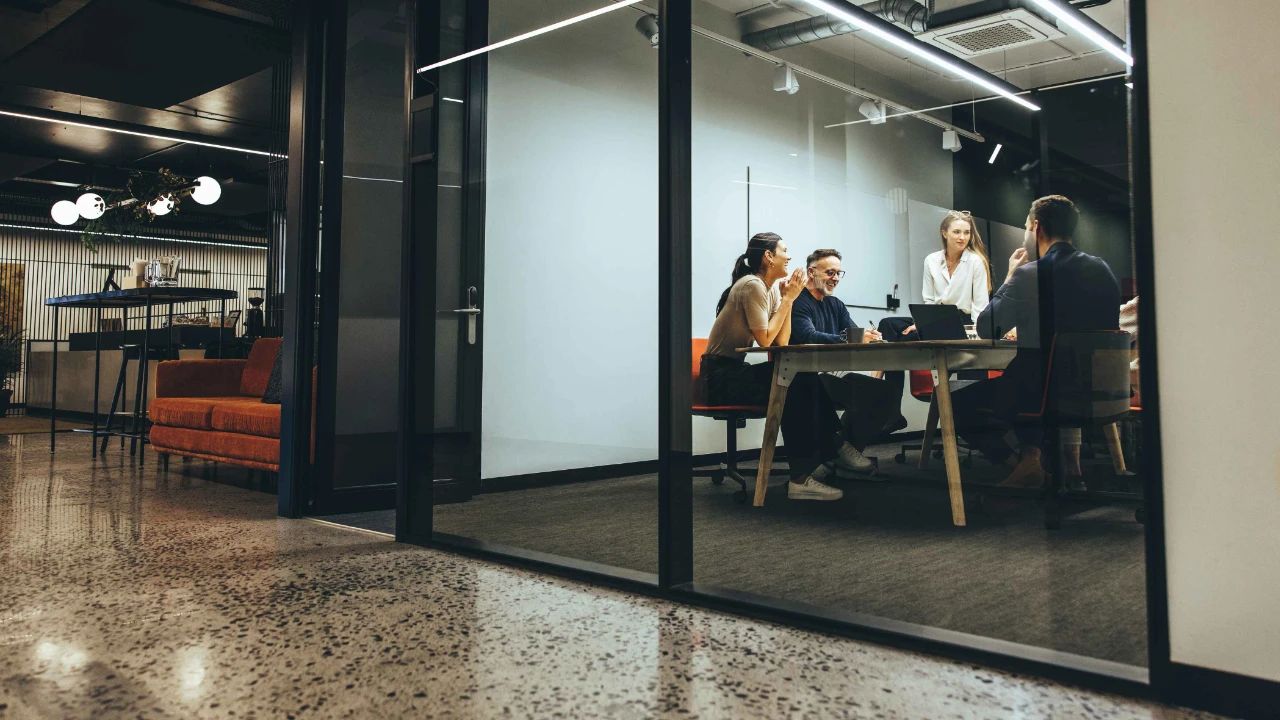Have you ever wondered how a well-thought-out workplace strategy can boost your organization’s success? Understanding workplace strategy is essential as it can significantly influence productivity, employee engagement and satisfaction, and overall business performance.
With the proper approach, you can create a workspace that not only meets your business objectives but also adapts to evolving work practices and employee needs.
In this article, we’ll break down the key concepts of an effective workplace strategy and highlight its benefits. Read on to understand how a strategic approach can transform your work environment and drive your business forward.
What Is a Workplace Strategy and Why Is It Important?
A workplace or business strategy is a comprehensive plan that aligns the physical workspace with an organization’s business goals, culture, and employee needs. It evaluates how space is used, understands employee work patterns, and creates an environment that supports both current and future objectives.
Aligns with Business Goals
It ensures that the workspace sustains the company’s strategic objectives, such as fostering collaboration through flexible meeting areas and open spaces.
Enhances Productivity and Employee Satisfaction
Tailoring the environment to employees’ needs and preferences increases productivity and job satisfaction by considering ergonomic design, work patterns, and technology.
Adapts to Changing Work Dynamics
It helps organizations adjust their office spaces to support new ways of working like remote working and hybrid workplaces, keeping the workspace relevant as business needs evolve.
How to Develop a Workplace Strategy Aligned with Business Objectives

Developing a workplace strategy that aligns with your business objectives involves several key steps:
1. Assess Current Needs and Goals
Start by evaluating your current workspace and gathering data on how it is used, including employee feedback and space utilization. Determine gaps and areas where the environment may not fully support your business objectives.
2. Define Business Objectives
Clearly outline your corporate goals, such as improving collaboration, increasing productivity, or supporting flexible work arrangements. Ensure that your workplace strategy is designed to fulfill these objectives.
3. Create a Detailed Plan
Develop a strategy that includes flexible workspace designs, such as open areas for collaboration and quiet zones for focused work. Integrate technology that supports remote work and streamline space utilization to match current and future needs.
4. Involve Stakeholders
Engage employees and management in the planning process to get their insights and ensure the strategy addresses their needs and preferences. This helps in creating a workspace that is both functional and supportive of your business objectives.
5. Implement and Review
Roll out the strategy and monitor its impact on work efficiency and employee workplace experience and satisfaction. Collect feedback regularly and make adjustments as needed to ensure the workspace continues to match your business objectives and adapt to changing needs.
Key Components of an Effective Workplace Strategy

An effective workplace strategy integrates several key components to ensure that the workspace supports business objectives, enhances productivity, and meets employee needs. Here are the main elements to consider:
Alignment with Business Objectives
The workplace strategy must match with the organization’s overall business objectives. This includes designing the workspace to support key activities that drive success, such as collaboration, innovation, or efficiency. For example, if increasing teamwork is a goal, the strategy should incorporate open spaces and flexible meeting areas.
Flexible Workspace Design
An effective workplace strategy includes a flexible design that accommodates various work styles and needs. This can involve:
- Activity-Based Areas: Spaces designed for specific activities, like quiet zones for focused work and collaborative areas for team projects.
- Modular Furniture: Adaptable furniture that can be reconfigured as needs change.
- Ergonomic Considerations: Furniture and layouts that promote comfort and reduce physical strain.
Technology Integration
Integrating technology is crucial for modern workplaces. The strategy should include:
- Advanced Tools: Technology that supports both in-office and remote work, such as video conferencing systems and collaborative software.
- Smart Systems: Systems that enhance efficiency, like automated lighting and climate control.
Space Utilization and Optimization
Effective space utilization ensures that office space is used efficiently while meeting the needs of employees. This involves:
- Maximizing Space: Designing layouts that make the best use of available space and avoid overcrowding.
- Future Planning: Planning for future growth or changes in work patterns to ensure the space remains functional over time.
Employee Experience and Well-Being
The strategy should prioritize employee experience and well-being, focusing on:
- Comfort and Satisfaction: Creating a workspace that enhances employee comfort and job satisfaction.
- Health and Safety: Incorporating elements that promote a healthy work environment, such as proper ventilation and ergonomics.
Adaptability to Changing Work Models
The workplace strategy should be versatile to evolving work models, including:
- Hybrid Work: Incorporating spaces that support both remote and in-office work.
- Agile Workspaces: Designing flexible spaces that can be quickly reconfigured to meet changing needs.
Stakeholder Involvement
Engaging stakeholders in the development process ensures that the strategy meets the needs of all parties. This includes:
- Employee Feedback: Gathering input from employees on their workspace needs and preferences.
- Management Input: Aligning the strategy with the management’s vision and organizational goals.
Implementation and Review
Effective strategies include a plan for implementation and regular review:
- Phased Implementation: Rolling out changes in phases to manage disruption.
- Ongoing Evaluation: Continuously assessing the effectiveness of the strategy and making adjustments as needed.
How Changing Work Dynamics Influenced Workplace Strategies

Changing work dynamics, such as the shift to remote and hybrid work, have significantly impacted workplace strategies. Here’s how these changes have influenced workplace design and management:
Rise of Hybrid and Remote Work
- Flexible Workspaces: Offices now feature hot-desking and adaptable areas to support both in-office and remote work or work from home. This flexibility allows spaces to be reconfigured based on current needs.
- Enhanced Technology: Organizations have invested in advanced video conferencing and collaboration tools to ensure seamless communication between remote and in-office employees.
Evolving Employee Expectations
- Work-Life Balance: There’s a growing emphasis on flexibility to accommodate employees’ desire for work-life balance. Workspaces now include ergonomic furniture and quiet areas to support well-being.
- Improved Employee Experience: To attract and retain talent, companies focus on creating environments that enhance employee satisfaction and engagement.
Shift Towards Collaborative and Agile Work Environments
- Activity-Based Workspaces: Modern offices include spaces for various work activities, such as collaborative zones and quiet areas, catering to different work styles.
- Agile Work Models: Organizations use agile work models to quickly adapt workspace configurations and meet evolving workplace needs and employee preferences.
Impact of the COVID-19 Pandemic
- Health and Safety: Increased attention to health measures, including improved ventilation and sanitization, has reshaped office designs.
- Remote Work Integration: The pandemic accelerated the adoption of remote work, influencing many companies to permanently incorporate remote work options into their strategies.
Aligning Your Workplace Environment with New Ways of Working
Aligning your workplace environment with new ways of working is essential for productivity and employee satisfaction. Here’s a concise guide to help you adapt your workspace to modern work models:
Understanding Work Activities and Employee Needs
- Analyze Work Patterns: Gather data on how employees work, their preferences for collaboration, and their needs for flexibility.
- Identify Key Activities: Determine primary work activities (meetings, focus tasks, etc.) to inform workspace design.
- Adapt to Expectations: Create environments that support both in-office and remote work to meet evolving employee expectations.
Designing Flexible Workspaces
- Flexible Layouts: Use adaptable layouts and modular furniture to support different work styles and tasks.
- Activity-Based Zones: Design specific areas for collaboration, focused work, and social interaction.
- Hybrid Work Integration: Include technology-enabled meeting rooms and hot-desking options for seamless hybrid work.
Incorporating Technology and Innovation
- Collaboration Tools: Invest in high-quality video conferencing and project management software.
- Smart Office Solutions: Implement systems for automated lighting, temperature control, and security.
- Connectivity: Ensure strong internet access and cloud resources for remote work.
Enhancing Employee Experience
- Comfort and Well-being: Provide ergonomic furniture, natural lighting, and quiet areas.
- Gather Feedback: Regularly collect and act on employee feedback about the work environment.
- Social Spaces: Create areas for social interaction and team-building.
Implementing and Managing Change
- Communicate Clearly: Explain the benefits of changes and how they’ll improve the workplace.
- Phased Rollout: Introduce changes gradually to manage adjustments smoothly.
- Evaluate Regularly: Continuously assess and refine the workplace to ensure it meets current needs.
Benefits of a Well-Defined Workplace Strategy for Employee Experience

A well-defined workplace strategy improves the employee experience, leading to a more engaged, productive, and satisfied workforce. Here are the key benefits:
Enhanced Productivity
A well-planned workplace strategy focuses on creating an environment that enables peak performance and reduces barriers to productivity.
- Optimized Workspaces: Tailored workspaces support various activities, ensuring the right environment for collaborative and individual tasks.
- Technology Integration: Implementing effective tools and technologies enhances workflows and overall efficiency.
- Flexible Work Arrangements: Options like remote or hybrid working help employees manage work-life balance better, boosting productivity.
Improved Employee Satisfaction
Prioritizing employee needs and preferences in your workplace strategy leads to higher satisfaction levels.
- Employee-Centric Design: Designing workspaces based on employee feedback ensures their needs and preferences are met, raising morale and satisfaction.
- Wellness and Comfort: Amenities that support physical and mental well-being, such as ergonomic furniture and wellness programs, contribute to a positive work environment.
- Flexibility and Autonomy: Giving employees control over their work environment and schedules increases satisfaction and motivation.
Higher Employee Engagement
A well-defined workplace strategy boosts engagement by fostering collaboration, innovation, and connection.
- Collaborative Spaces: Areas that facilitate teamwork and communication help build stronger relationships.
- Purposeful Design: Workplaces reflecting the company’s values and culture make employees feel more connected to the organization’s mission.
- Recognition and Support: Spaces that celebrate achievements and support professional growth enhance engagement and loyalty.
Better Talent Attraction and Retention
An effective workplace strategy attracts and retains top talent.
- Attractive Work Environment: A modern, well-designed workplace attracts prospective employees.
- Employee Retention: Satisfied employees are more likely to stay, reducing turnover rates and associated costs.
- Competitive Advantage: A reputation for an excellent workplace sets your organization apart from competitors.
Enhanced Business Performance
A well-defined workplace strategy contributes to better business performance.
- Aligned Goals: A workplace that supports business objectives leads to better overall performance.
- Increased Innovation: A supportive environment fosters creativity and innovation, driving growth.
- Cost Efficiency: Optimizing office space and resources leads to cost savings and better return on investment.
Measuring the Success of Your Workplace Strategy
Measuring the success of your workplace strategy ensures it matches the corporate goals and meets employee needs. Here’s how to evaluate its effectiveness:
Gather Employee Feedback
Regularly collecting feedback is crucial to understanding the workplace strategy’s performance.
- Surveys and Questionnaires: Routine surveys gauge satisfaction, productivity, and engagement.
- Focus Groups: Gain deeper insights into the workplace environment and strategy specifics.
- Suggestion Boxes: Encourage anonymous suggestions for honest feedback on improvements.
Evaluate Performance Metrics
Assess key performance indicators (KPIs) to determine the strategy’s impact.
- Productivity Levels: Monitor changes in efficiency to see if the strategy enhances productivity.
- Employee Engagement Scores: Track engagement to measure support for morale and commitment.
- Turnover Rates: Analyze turnover to assess retention of top talent.
Analyze Workplace Utilization
Understand office space usage to gain insights into the strategy’s effectiveness.
- Space Utilization Reports: Review data to see frequently and underutilized areas.
- Occupancy Sensors: Gather real-time usage data with sensors.
- Desk and Room Booking Systems: Monitor booking trends to identify workspace usage.
Assess Business Performance
Evaluate the strategy’s contribution to broader business metrics.
- Financial Performance: Analyze cost savings from optimized space and reduced overheads.
- Innovation and Collaboration: Measure impacts on innovation through project outcomes and feedback.
- Client Satisfaction: Consider client feedback to enhance interactions and satisfaction.
Conduct Benchmarking
Compare your strategy against industry standards and best practices.
- Industry Benchmarks: Evaluate how your strategy compares to competitors.
- Best Practices: Implement leading practices for continuous improvement.
Continuous Improvement
Regularly review and refine your strategy based on data and feedback.
- Iterative Reviews: Ensure the strategy for your organization aligns with evolving goals and needs.
- Pilot Programs: Test new ideas and gather feedback before wider implementation.
- Ongoing Training: Support employees in adapting to new work strategies and tools.
Final Thoughts
Developing and implementing a well-defined workplace strategy is essential for aligning your organization’s workspace with business objectives, enhancing productivity, and improving employee satisfaction.
By assessing current needs, involving stakeholders, and continuously refining the strategy, businesses can create a dynamic and adaptable work environment.
This not only boosts employee engagement and retention but also drives overall business performance, securing long-term success in an ever-evolving work landscape.
Frequently Asked Questions
What is workplace strategy, and why is it important?
Workplace strategy is a foundational strategy designed to align your company’s physical space with its strategic business goals and employee needs. Here’s why it’s important:
Aligning with Business Goals: A well-developed workplace strategy supports your business’s processes and corporate needs by creating an environment that enhances performance and achieves business goals.
Facilitating Effective Work Patterns: It considers different work patterns with the work environment to enable peak performance and reduce cost, allowing for both remote and hybrid working models that improve efficiency.
Optimizing Facilities Management: Effective facilities management ensures that the physical space and real estate portfolio are utilized efficiently, enabling peak performance and reducing absenteeism and presenteeism.
Empowering Employees: The strategy helps you create the best workplace solution that supports various work settings, from collaborative areas to quiet zones, which is important to employees and enhances their ability to work effectively.
Strategic Alignment: Without a strategy in place, you may struggle to meet the dynamic alignment between your organization’s goals and employee needs, impacting your people and business.
The goal is to create a workplace that aligns with your business objectives and employee needs, fostering a productive and supportive environment.
How does workplace strategy improve employee engagement and satisfaction?
A well-executed workplace strategy can quite boost employee engagement and satisfaction by addressing their needs and preferences. Key elements include:
Listening to Your Employees: With a better understanding of how people work and what they need from their work environment helps you create a workplace that aligns with their expectations regarding their work environment and enhances their well-being.
Providing Flexibility: Offering greater flexibility through hybrid working and remote working options allows employees to adapt their work patterns to their personal and professional needs.
Enhancing the Work Environment: Designing spaces that enable peak performance and reduce stress ensures that employees have a supportive work environment.
Empowering Employees: By integrating feedback and providing a work environment that caters to different work settings, you empower employees to work more efficiently and comfortably, addressing specific team needs.
Aligning with Business and People Strategies: A strategy that integrates business and people strategies ensures that employees feel valued and their needs are met, which leads to higher engagement and satisfaction.
Implementing a workplace strategy that focuses on these aspects creates a more engaging and satisfying environment for employees.
What are the steps involved in developing a workplace strategy?
Developing a workplace strategy involves several key steps to ensure alignment with your company’s processes and employee needs. Here’s an overview:
Assessment of Current Workplace: Begin with an understanding of your current workplace, including its strengths and limitations, to inform the strategy’s development.
Engagement with Workplace Consultants: Collaborate with workplace consultants to gain insights and make informed decisions based on their expertise in different disciplines.
Designing the Strategy: Develop a strategy that takes into account your real estate portfolio, facilities management needs, and your workplace strategy needs to create effective work settings. The workplace strategy is developed by considering various factors such as current workplace limitations, employee feedback, and business goals.
Implementation: Put the strategy in place by adjusting your physical space to better support hybrid and remote working models, and optimize facilities to improve efficiency.
Evaluation and Adjustment: Continuously monitor the effectiveness of the strategy and make adjustments to align with changing work patterns and business goals.
Following these steps ensures that the strategy is comprehensive and tailored to your organisation’s needs.
How can workplace strategy help manage remote and hybrid work models?
A well-developed workplace strategy is crucial for effectively managing remote and hybrid work models. Key considerations include:
Creating a Flexible Environment: Develop a work environment that accommodates both remote and hybrid working by providing the necessary tools and technologies for seamless collaboration.
Supporting Different Work Patterns: Design spaces and systems that support various work patterns and facilitate effective work activities, whether employees want to work in the office or remotely.
Integration of Technology: Implement technology solutions that enhance connectivity and support the changing needs of remote and hybrid work models.
Facilitating Communication: Ensure that communication tools and strategies are in place to keep employees connected and engaged, regardless of their work location.
Adapting Facilities Management: Adjust facilities management practices to support flexible work arrangements and optimize the use of physical space.
A strategic approach helps you create a work environment that supports both remote and hybrid models, enabling peak performance across all work settings.
What role does technology play in an effective workplace strategy?
Technology is essential in a workplace strategy for enhancing productivity and managing various work models. Key technological aspects include:
Supporting Work Activities: Integrate technology that supports a range of work activities, from remote working to in-office collaboration, ensuring seamless operations.
Optimizing Facilities Management: Utilize smart office solutions and data analytics to optimize facilities management, improve efficiency, and reduce costs.
Facilitating Communication: Employ advanced communication tools to maintain connectivity and support hybrid working environments.
Enhancing Employee Experience: Providing employees with technology that aligns with their needs and work patterns, empowering them to perform at their best.
Managing Corporate Real Estate: Use technology to manage your real estate portfolio effectively, making informed decisions about space utilization and investment.
Incorporating these technological elements into your workplace strategy enhances operational efficiency and supports a flexible, productive work environment.

